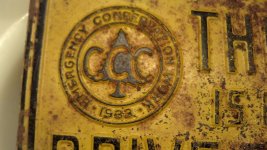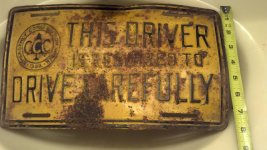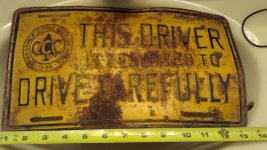mariposagold
Bronze Member
- May 1, 2012
- 1,219
- 886
- Detector(s) used
- MXT Pro, Classic SL, Bullseye II Probe, Garrett Groundhog.
- Primary Interest:
- All Treasure Hunting
I embarked on a mission with TNet Stealth member, Rob, aka: andre1002 on Thursday. The Mission? Find a new hunting spot for coins, Gold Nuggets, Relics or anything whatsoever, somewhat near my home in the Southern end of the Mother Lode. We drove out in the sticks and picked a spot. After an hour or so, with no meaningful finds, we moved to spot two. Again, nothing meaningful. I'm pretty sure we were at least 3 hours of hunting and getting flusters. So we move to spot three, and again, finding nothing meaningful, but trash that wasn't present at the first two sites. Rob finds a few items, like an old Chisel. I'm not finding anything. After about an hour and a half, and burning sunlight fast. We meat up close to where we started at on site 3. We begin swinging a slow path toward the car, when, bamo. A huge area lights up my MXT Pro. Great, betcha a pile of cans buried in one spot. But I'll dig them all just because it's better than a stick in the eye. Rotted tin can after rotted tin can, I painfully pull from the whole. As I dug deeper, I noticed the unmistakable signs of a burn pit. The signals continued each time a pulled what I thought was the end of it. Finally, I caught the edge of something bigger than a tine can. I slowly worked around it until I could free all sides. As I pulled it out, I could see the slight signs of what I believed to be an old license plate. That sent me into excited mode. But it wasn't just an old license plate. It was much bigger. As I wiped the dirt from it, this is what I saw.



Civilian Conservation Corps - Wikipedia, the free encyclopedia
"The Civilian Conservation Corps (CCC) was a public work relief program that operated from 1933 to 1942 in the United States for unemployed, unmarried men from relief families as part of the New Deal. Originally for young men ages 18–23, it was eventually expanded to young men ages 17-28.[1] Robert Fechner was the head of the agency. It was a major part of President Franklin D. Roosevelt's New Deal that provided unskilled manual labor jobs related to the conservation and development of natural resources in rural lands owned by federal, state and local governments. The CCC was designed to provide jobs for young men, to relieve families who had difficulty finding jobs during the Great Depression in the United States while at the same time implementing a general natural resource conservation program in every state and territory. Maximum enrollment at any one time was 300,000; in nine years 3 million young men participated in the CCC, which provided them with shelter, clothing, and food, together with a small wage of $30 a month ($25 of which had to be sent home to their families).[2]
Franklin D Roosevelt's Emergency Conservation Work Act (1933) Placard.
"The Emergency Conservation Work Act was the first major work relief act passed as part of President Franklin D. Roosevelt's New Deal programs. Sometimes referred to as the Reforestation Relief Act, the legislation provided for the creation of a government agency that would put unemployed people to work developing conservation infrastructure on lands owned by the federal, state, and local governments. The following is the text of the legislation, which was approved by Congress on March 31, 1933, and signed into law by Roosevelt."
ABC-CLIO SCHOOLS
The program lasted only 9 years and eventually took backseat to the war effort.
I have found NO OTHER examples of this placard online. I am happy as a clam to have saved it from becoming a piece of rotten metal.
I will be returning to that site soon. Possibly with a sifter.
Thanks for sharing my excitement.
HH
MariposaGold.



Civilian Conservation Corps - Wikipedia, the free encyclopedia
"The Civilian Conservation Corps (CCC) was a public work relief program that operated from 1933 to 1942 in the United States for unemployed, unmarried men from relief families as part of the New Deal. Originally for young men ages 18–23, it was eventually expanded to young men ages 17-28.[1] Robert Fechner was the head of the agency. It was a major part of President Franklin D. Roosevelt's New Deal that provided unskilled manual labor jobs related to the conservation and development of natural resources in rural lands owned by federal, state and local governments. The CCC was designed to provide jobs for young men, to relieve families who had difficulty finding jobs during the Great Depression in the United States while at the same time implementing a general natural resource conservation program in every state and territory. Maximum enrollment at any one time was 300,000; in nine years 3 million young men participated in the CCC, which provided them with shelter, clothing, and food, together with a small wage of $30 a month ($25 of which had to be sent home to their families).[2]
Franklin D Roosevelt's Emergency Conservation Work Act (1933) Placard.
"The Emergency Conservation Work Act was the first major work relief act passed as part of President Franklin D. Roosevelt's New Deal programs. Sometimes referred to as the Reforestation Relief Act, the legislation provided for the creation of a government agency that would put unemployed people to work developing conservation infrastructure on lands owned by the federal, state, and local governments. The following is the text of the legislation, which was approved by Congress on March 31, 1933, and signed into law by Roosevelt."
ABC-CLIO SCHOOLS
The program lasted only 9 years and eventually took backseat to the war effort.
I have found NO OTHER examples of this placard online. I am happy as a clam to have saved it from becoming a piece of rotten metal.
I will be returning to that site soon. Possibly with a sifter.
Thanks for sharing my excitement.
HH
MariposaGold.
Upvote
7


 ! Great find , it will look cool up on the garage wall !
! Great find , it will look cool up on the garage wall !  Not much value in that condition , but who cares it's cool ! I had a CCC plate in my collection back in the 1990's . I sold it for about $25.00 back then .
Not much value in that condition , but who cares it's cool ! I had a CCC plate in my collection back in the 1990's . I sold it for about $25.00 back then . 


